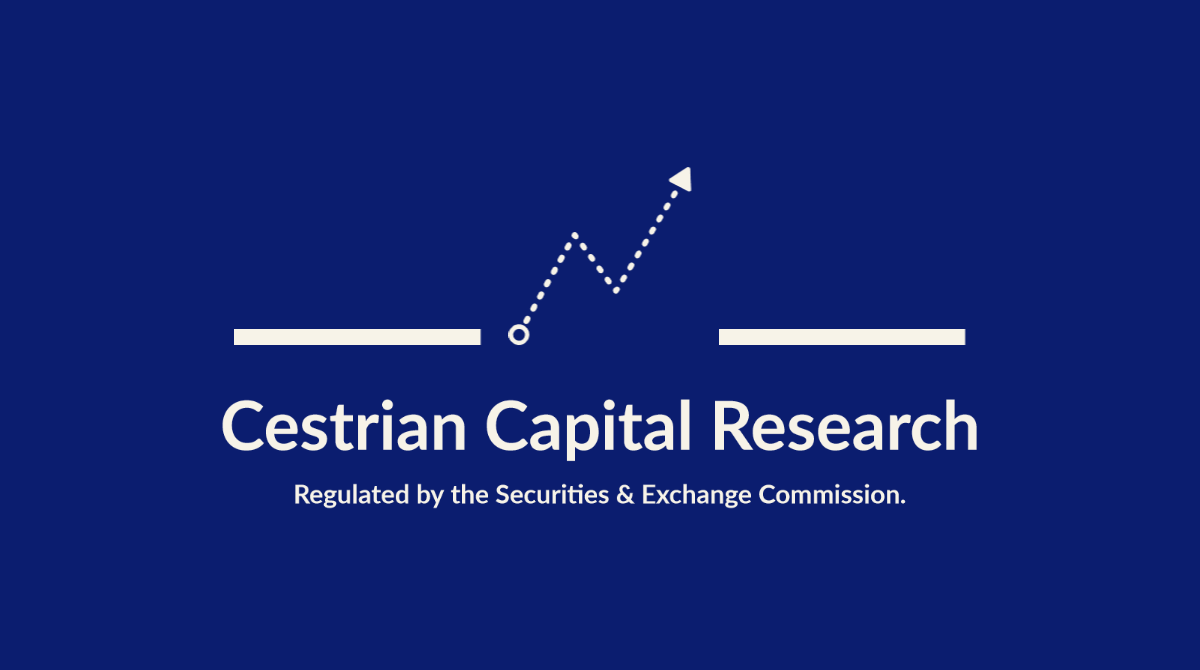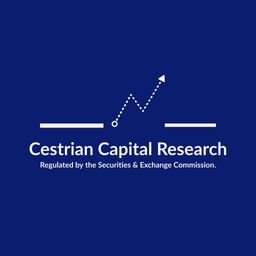Alphabet (GOOGL) Q4 FY2024 Earnings Review [No Paywall]
![Alphabet (GOOGL) Q4 FY2024 Earnings Review [No Paywall]](/content/images/size/w960/2025/02/unnamed--1-.png)
By Yimin Xu. GOOGL sold off after earnings - is this the beginning of the top?
DISCLAIMER: This note is intended for US recipients only and, in particular, is not directed at, nor intended to be relied upon by any UK recipients. Any information or analysis in this note is not an offer to sell or the solicitation of an offer to buy any securities. Nothing in this note is intended to be investment advice and nor should it be relied upon to make investment decisions. Cestrian Capital Research, Inc., its employees, agents or affiliates, including the author of this note, or related persons, may have a position in any stocks, security, or financial instrument referenced in this note. Any opinions, analyses, or probabilities expressed in this note are those of the author as of the note's date of publication and are subject to change without notice. Companies referenced in this note or their employees or affiliates may be customers of Cestrian Capital Research, Inc. Cestrian Capital Research, Inc. values both its independence and transparency and does not believe that this presents a material potential conflict of interest or impacts the content of its research or publications.
Hi Cestrian friends,
Why did GOOGL tank by 7% after earnings? Many fund managers will say “nobody knows” or “more sellers than buyers”. Good for them.
The short answer is twofold, and we actually start today’s article by addressing them first. You can read this very first section, be satisfied, and get on with the more interesting things of the day. Or even better (for me), share it with your friends and colleagues first, get their “oh nice” response, then get on with the day.
First, Alphabet’s reported sales figure was below the analyst estimates by just 0.2%. It doesn’t sound like a lot, but historically, when sales exceeded estimates by less than 2%, Alphabet’s next-day share price nearly always dropped.

Secondly, Google Cloud’s Q4, while at an impressive 30% YoY growth rate, actually decelerated from Q3, dragging down the overall revenue growth. At the same time, Alphabet plans to spend $75 billion in CapEx for 2025 into the weakening growth. It makes investors anxious about the return on capital and actual AI monetisation.
For those who are interested in the comprehensive analysis of the earnings, valuation, and price technicals, please read on!
By Yimin Xu, February 06, 2025
🛩️ My private channel at Cestrian to provide winning trade ideas in 3 key areas:
- Macro Instruments – including TLT, Fed Funds, Gold, Silver, USO
- Crypto – including BTC, ETH, SOL, COIN and Crypto miners
- Large-cap Equities & Private Credit – Magnificent 7, Financials, Consumer, Business Development Companies (BDCs), Chinese ADRs
Our subscribers enjoyed a BTC buy alert at $57k in August, and ETH at $2600 in September.
🕊️ Right now, you can claim a 7-day free all-access trial via Cestrian here:

1. Growth Highlights
Alphabet’s Q4 2024 Revenue Breakdown

Alphabet is an interconnected conglomerate with many different business segments, across Search, Advertising, Cloud Services, Streaming, Mobile Hardware, Applications, and Self-driving Cars. The company’s current goal is to lead the AI arms race and fully integrate AI technologies across its Search, Cloud, and consumer products.
Google Search is by far the biggest revenue driver, contributing to 56% of Alphabet’s revenue. Google Cloud, Google Subscriptions, and YouTube ads are similar in their revenue share at 11-12% each. It should be noted that from Q3, YouTube ads have moved up by 1% in revenue share, while Google Cloud moved down by 1%. This is probably what investors do not want to see.
Quarterly Revenue

Alphabet’s quarterly revenue was $96.5 billion, reflecting a 12% increase from Q4 2023. This is quite a slow down from Q3’s 15%, and also slower than the Q4 of a year ago. The deceleration calls into question on the rate of AI monetisation by Alphabet amidst heavy CapEx spending, which we will get to later.
TTM Revenue

Alphabet’s trailing twelve-month (TTM) revenue reached $350 billion, +14% YoY. The strong past 3 quarters have kept the TTM revenue growth only 50bp slower than Q3.
Product & Service Performance YoY

Google Search & Other Ads revenue reached $54 billion, growing 13% YoY. This is an acceleration from Q3’s 12%. Alphabet attributes the growth in Search to the popularity of AI Overviews, Circle to Search, and ad bidding adjustments. AI Overviews are now in over 100 countries, while Circle to Search is available on more than 200 million Android devices.
Personally, I think Gemini is much poorer than ChatGPT in text-based conversations, but its image creation is superior.
YouTube Ads grew by 14% to $10.5 billion. This again is a nice acceleration from Q3’s 12%, thanks to higher engagement in Shorts (now 15% of TV watch time), election ad spend, and YouTube Shopping expansion.
Personally, I love YouTube as a source of entertainment and knowledge, and I am not surprised it is doing well. YouTube enjoys an unrivalled ecosystem of user generated long-form content. This complements the in-house production streaming giants of Netflix and Prime, while competing with Reels and TikTok on the short-form side.
Google Cloud hit $12 billion, up 30% YoY. Unfortunately, this was a large deceleration from Q3’s 35% growth, and the likely reason the stock was punished by investors after earnings.
In Q4, Cloud customers consumed 8x more compute power for AI than 18 months ago. Vertex AI (a unified AI development platform for building and using generative AI based on Gemini) usage increased 20x YoY, with 5x more customers.
Google Subscriptions, Platform, and Devices brought home $11.6 billion, up 8% YoY. This was another deceleration from Q3’s impressive 28% growth, despite the busy holiday season. Google One and YouTube Premium continued expanding, while there was limited growth in Pixel hardware. A trend we also see in Apple’s iPhone.
Other Bets revenue reached $400 million, which is actually 39% lower than a year ago. Waymo reported 150,000 weekly rides, in line with Q3. Waymo is looking to expand to Austin, Atlanta, and Miami, directly challenging Musk’s Cybercab plan by partnering with Uber. But high investment costs impacted its profitability.
Regional Performance

Alphabet’s US market brought in $47.4 billion, up 13% YoY. Growth drivers included higher Cloud, advertising, and election spending.
EMEA grew by 11% to $28.2 billion, mostly thanks to the growth of Cloud and YouTube services.
APAC grew by 9% to $15.2 billion. Alphabet cites the moderated growth due to China regulatory headwind. China is reportedly considering an Alphabet App Store investigation, after US implemented 10% tariffs in February. These regulatory headwinds are unlikely receding anytime soon, but it could take multiple quarters for the full impact to become known.
Other Americas grew by an impressive22% to $5.7 billion due to increased adoption of Cloud and YouTube services.
The major geopolitical headwind for Google is regulation across the US (DoJ), Europe (EU antitrust), and China. This is likely a reason why its valuation is lower than its Magnificent-7 peers.
2. Profitability Margins

Alphabet’s profitability margins were consistent across the 2024 quarters, which is not something that should be taken for granted.

Alphabet’s operating margin was 32%, up over 3% from a year ago. Google Services margin increased to 39%, while Google Cloud margin nearly doubled to 17.5%.

Alphabet’s Free Cash Flow margins also improved from 1.7% last year or 11.6% in Q3, to a nice 19% in Q4. This brings the TTM to $48 billion.
(Note that my calculation differs from Alphabet’s SEC filing, because I approach the calculation through normalised cashflows, e.g. accounting for the taxes relevant to the period, where as Alphabet’s number is higher as there was nearly 0 taxes in actual cash flows for the quarter.)

Alphabet’s CapEx was $14 billion, comparable to the previous 3 quarters as a percentage of revenue, bringing the total to $52 billion for the year.
What shocked the investors was an announcement of $75 billion in CapEx planned for 2025. They are primarily planned for AI-related infrastructure, including TPUs and data centres. The drive for this high spending comes from Cloud capacity constraints.
The investor concern is whether this huge CapEx (a 50% increase from 2024) can see good ROIC, which is far from certain. The same story goes for Microsoft, Meta, and Amazon.

Finally, 2024 was a strong year for EPS growth. While TTM EPS growth after Q4 slows to 39%, that is a big number still.
3. Share Buybacks
Alphabet returned $15.6 billion to shareholders in Q4, including $13.2 billion in stock buybacks (65 million shares repurchased) and $2.4 billion in dividends.
Overall in 2024, Alphabet spent $62.2 billion on buybacks, with shares moving up by 36%.
4. Valuation Is Reasonable

GOOGL currently trades at 6.8x EV/ Revenue for 14% TTM growth, or 24x P/E for 39% TTM growth. These are reasonable valuation multiples.
While the stock price did well in 2024, there has been a lot of volatility (especially a brutal July-September selloff). The two biggest issues of concern are 1) regulatory headwinds globally, across US, EU and China, and 2) uncertain return on capital during heightened CapEx spending on AI.
There is not a lot Alphabet can do in the former. The founders are not best friends with the White House (Trump repeated complained about a biased Google Search during his campaign). EU does not like big tech. China is picking on Google and Apple as part of the trade war retaliation. These are medium term headwinds that don’t easily recede.
Around CapEx and AI, Alphabet may feel it cannot afford to lag its competitors, as it did in the early days of ChatGPT 3. It is now more than willing to cannibalise its Search ad business by integrating it with AI, otherwise average users will slowly abandon the platform. One can argue that the big CapEx is simply the cost of staying in the competition against Meta and Microsoft.
Plus, once we get to the inference stage of the cycle, where real-world AI applications start to boom, there are much bigger targets at play to justify the early spending.
5. Technical Analysis
GOOGL Daily (https://www.tradingview.com/x/4oHkKyXU/)

Yesterday’s 7% drop does not threaten the bullish structure of GOOGL’s technicals. It is being supported by the July 2024 high and more recent December and January lows. I still favour it moving towards its wave 3 target at $222-230, and eventually above $240. Structurally, falling below the November low for $163 (wave circle-ii low) would worry me.
Trade Idea?
I am watching the open on Thursday morning for a potential trade setup. The target would be the $240-255 region, with a stop loss below the December gap at $174. Ideally, we want a price entry near the bottom of the blue box. The second half of February tends to be volatile for markets generally, which warrants a look out for higher risk-reward.
GOOGL Weekly (https://www.tradingview.com/x/KvAAIHRy/)

In terms of the longer term technicals, eventually we are looking at $400+ in this cycle, likely 3 years out. Near term there will be a lot of volatility as regulatory hurdles and CapEx intensify while growth finally benefits from the AI investment. However, GOOGL’s share repurchase program should help support the stock price during this phase of uncertainty.
If the price falls out of the bottom of the channel, we will reevaluate the possibility of a near-term top, but it’s not my main expectation right now.
6. Rating: Overweight
I think the relatively cheap valuation and strong price technicals deserves an unchanged rating of overweight.
This does not mean I am dismissive of investor concerns around Google Cloud slowdown and AI spend. Rather, I keep a close watch of their movements over time, combined with the bigger macro picture and price technicals before changing my rating.

